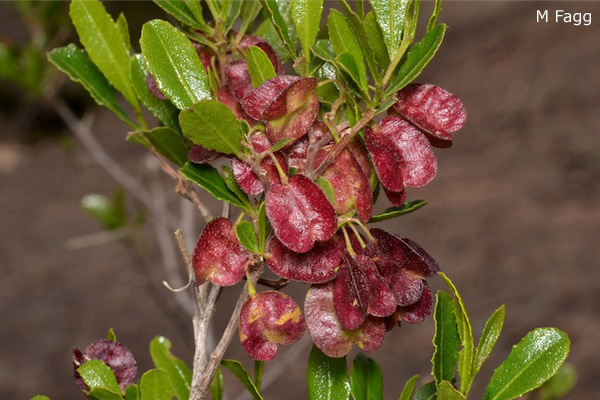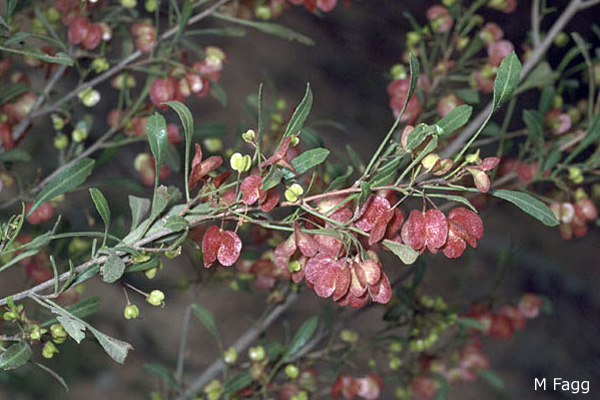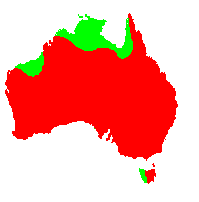General Description:
Dodonaea is predominantly an Australian genus which is well distributed in all states. There are 69 species and 60 of them are endemic to Australia. They are commonly called ‘hop bushes’ because the colourful fruits resemble the fruits used in brewing.
Dodonaea viscosa is a very variable species with several subspecies recognised. In habit it ranges from a small shrub to a small tree up to 8 metres high. Features of the various subspecies found in Australia are:
- subsp.viscosa – compact, spreading shrub 1 – 3 metres high. The leaves are wedge-shaped (cuneate) to narrow-obovate (egg-shaped), 1.5 – 3 cm long with a short, blunt point or occasionally 2 – 3 toothed. This subspecies is generally found in mallee scrub to open forests in South Australia, Victoria and New South Wales.
- subsp.burmanniana– small tree 2 – 6 metres high with narrower and longer leaves than subsp.viscosa (6.5 – 15 cm long). This subspecies is found from north eastern New South Wales to north-east Queensland.
- subsp.angustifolia – compact shrub to 3 metres high with much narrower leaves than subsp.burmanniana and of similar length. This subspecies is found from south east Queensland to Victoria.
- subsp.cuneata– spreading shrub to 3 m high with . Leaves with cuneate to angular-obovate or narrow-obovate leaves 1.2 – 3 cm long and 4 – 9 mm wide. This subspecies is widespread in inland districts and is found in mallee scrub and open forests.
- subsp.mucronulata – medium shrub with with leaves that are long and narrow, tapering to the base (spathulate) and about 2.5 – 6 cm long. This subspecies is mainly confirned to arid areas.
- subsp.spathulata – medium shrub similar to var.mucronulata but with leaves having a narrow base and a shorter stalk. This subspecies is found in temperate and semi-arid areas in all states except the Northern Territory.
- subsp.angustissima – erect bushy shrub 2 – 4 metres high and distingushed from the other subspecies by its fine delicate foliage. Leaves are without any stalk (sessile), linear to narrow-oblong, 3 – 9.5 cm long with an acute tip. This subspecies is widespread and found in forests, woodlands and sandplain areas in the south and central parts of the continent.
Like most dodonaeas, male and female flowers are borne on separate plants (dioecious) but they are visually insignificant. The 3-4 winged fruits vary in colour from cream to red. These only occur on female plants.
In cultivation, the various forms generally require a light, well-drained soil in a sunny position. They are generally very hardy and worth growing for the colourful fruits. A purple foliaged form is in cultivation – this grows into a bushy shrub up to 3 metres high but is believed to be of New Zealand origin. Most forms will tolerate at least moderate frosts and withstand extended dry conditions.
Propagation can be carried out from seed following pretreatment in near boiling water. However, for horticultural purposes, propagation from cuttings is the preferred method as this ensures that female plants (with the attractive fruits) are propagated. For further information on propagation, see Dodonaea – The Hop Bush, in Issue 27 of Australian Plants online.

Dodonaea viscosa subsp. cuneata
Photo: Murray Fagg – Australian National Botanic Gardens

Dodonaea viscosa subsp. spathulata
Photo: Murray Fagg – Australian National Botanic Gardens
 Australian Native Plants Society (Australia)
Australian Native Plants Society (Australia)